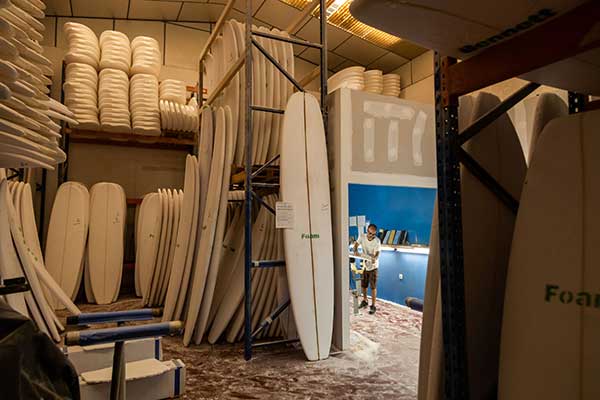Learn about the fascinating process of surfboard manufacturing, the production techniques, and the various materials used in the designs.

Meeting production standards is essential for creating professional-grade boards in the surfing industry. This is why specific materials and manufacturing processes are employed. Over time, the designs and materials have been modified to accommodate new riding styles and enhance the surfing experience of beginners and experts.
Read below to learn more about the various production standards, materials, and techniques used in surfboard manufacturing.
Surfboards are composed of several different materials depending on the needs and skill level of the rider. They were originally carved from heavy wood by Polynesians, who invented surfing over a millennia ago. However, modern boards are designed to be sleek and streamlined.
The main component of all surfboards is foam blanks used as the inner core to form the board’s structure. Fiberglass and polyester resin were previously used as coatings on this foam, which was traditionally made of polyurethane or expanded polystyrene.
Due to advances in surfboard design, the most recent construction of surfboards uses polystyrene, fiberglass, epoxy resin, and waxed styrene. This combination creates less resistance and a smoother ride for surfing-related water sports, including wakesurfing and paddleboarding.
Chemicals such as methyl, ethyl, ketone, peroxide, MEKP catalyst solution, and glass microspheres can also be mixed into the epoxy resin to harden and repair the board when necessary.
While surfboards are designed with similar elongated shapes and rounded sides, they’re still created in a range of shapes and lengths to suit different surfing styles, types of waves, and weight distributions of the surfer. The main types are longboards, shortboards, and mid-lengths.
Boards measuring 8 feet or more are considered longboards. They are the traditional boards created for cruising gentler waves and casual surfing. Meanwhile, shortboards of about 6 feet are the opposite and optimized for speed, control, and maneuvering quick turns through bigger and faster waves.
The popularity of mid-length boards has grown over time among intermediate surfers because of their versatility in gliding through powerful waves and catching point breaks. They’re also stable and fall somewhere between long and short boards in terms of size.
There are generally three ways surfboards are designed and created. These production techniques are constantly undergoing experimentation and refinement thanks to emerging technology.
Surfboard manufacturers typically use pop-out and machined molded techniques, while master artisans use hand-shaped designs. The pop-outs are the most affordable option for small businesses as the boards can be made using a hardened mold around the foam and produced in large quantities.
Machine-molded techniques are becoming standard practice for more established surfboard production companies that can use specialized equipment. The boards are shaped using a highly accurate mold; then, a CNC machine takes over to create the rest using the same mold. Doing this has improved quality assurance and standard practice, making manufacturing more efficient during mass production.
Finally, customized boards for pro surfers and interested customers are carved using the hand shaped method and a foam block. The expert surfboard maker will use craftsmanship to shape the board by hand using tools such as an electric planer, sanding block, mixing and measuring tools, and protective gear in a workshop. Thus, each board is created uniquely, emphasizing precision and working slower to perfect the finer details.
The manufacturing process starts with creating the foam blank using a surfboard-shaped cement mold divided into two halves and lined with paper to separate the foam and mold. From here, the halves are joined, and the combined materials, such as polyurethane and polystyrene, are poured into the mold and heated to create the thick and hard foam core.
To provide a solid structure and prevent the board from breaking in two, a stringer is attached between the two halves, clamped back together, and left to dry. At this stage, the surfboard is still a formless blank and thus needs shaping, sanding, glassing, and laminating to be completed.
A surfboard template is outlined onto the core, then carved out and smoothened with a planer, sandpaper, and fine paper along the sides for an elegantly curved and proportional board shape. The final steps include laminating the board with fiberglass, attaching the fin, painting the colors and patterns then coating it with the epoxy resin.
Manufacturing surfboards consists of using foam and chemical mixtures to form the outer core of the board. Then each board is designed and shaped to suit the riding style and skills of the surfer, allowing them to navigate different types of waves.
These are part of the production standards for surfing companies and shops to create high-quality and effective surfboards for professionals and novices.
About the Author:
Ellen N. Rucker, from Tampa, Florida, is a freelance writer and long-time surf longboarder who primarily writes about sports hobbies and fitness. She enjoys outdoor adventures with her partner and exploring America’s undiscovered beaches.
In this episode, I sat down with Beejan Giga, Director | Partner and Caleb Emerson, Senior Results Manager at Carpedia International. We discussed the insights behind their recent Industry Today article, “Thinking Three Moves Ahead” and together we explored how manufacturers can plan more strategically, align with their suppliers, and build the operational discipline needed to support intentional, sustainable growth. It was a conversation packed with practical perspectives on navigating a fast-changing industry landscape.